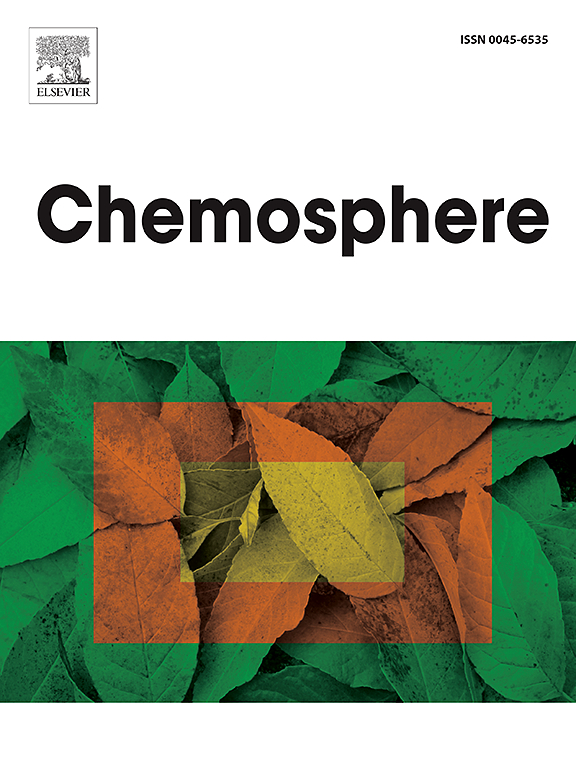微粒六价铬暴露会诱发大鼠和人类肺组织中的 DNA 双链断裂并抑制同源重组修复。
IF 8.1
2区 环境科学与生态学
Q1 ENVIRONMENTAL SCIENCES
引用次数: 0
摘要
肺癌是一个重要的人类健康问题,因为它的死亡率很高,许多病例是由烟草以外的环境化学品引起的。颗粒六价铬[Cr(VI)]是公认的人类肺癌致癌物,但Cr(VI)如何诱发肺癌尚不清楚。染色体不稳定是肺癌的一个标志,被认为是Cr(VI)诱导肺癌的主要驱动因素。我们在体外培养的人肺细胞的研究表明,颗粒Cr(VI)在细胞周期的S晚期和G2期诱导DNA双链断裂,并通过同源重组修复,同源重组是DNA双链断裂的主要修复途径之一。我们之前的数据表明,长时间暴露于Cr(VI)中可以通过靶向介导同源重组的关键蛋白RAD51来抑制同源重组修复。因此,颗粒Cr(VI)诱导的DNA损伤合并DNA修复失败可导致染色体不稳定。在本研究中,我们将这些结果转化为Cr(VI)暴露工人的大鼠肺组织和肺肿瘤组织。Wistar大鼠经口咽滴入铬酸锌盐溶液或盐溶液,每周重复一次,连续90天。我们观察到DNA双链断裂以浓度依赖的方式增加,但暴露90天后大鼠肺部同源重组修复减少。值得注意的是,这些影响在细支气管比肺泡更明显。我们还考虑了Cr(VI)相关的人肺肿瘤的这些影响,并观察到与邻近正常肺组织相比,肺肿瘤组织中DNA双链断裂增加,RAD51水平降低。因此,Cr(VI)诱导的DNA双链断裂的诱导和同源重组修复的抑制从培养细胞转化为实验动物、肿瘤邻近的正常肺组织和Cr(VI)相关的人肺肿瘤。本文章由计算机程序翻译,如有差异,请以英文原文为准。

Particulate hexavalent chromium exposure induces DNA double-strand breaks and inhibits homologous recombination repair in rat and human lung tissues
Lung cancer is an important human health concern because of its high mortality rate, with many cases caused by environmental chemicals other than tobacco. Particulate hexavalent chromium [Cr(VI)] is a well-established human lung carcinogen, but how Cr(VI) induces lung cancer is poorly understood. Chromosome instability, a hallmark of lung cancer, is considered a major driving factor in Cr(VI)-induced lung cancer. Our previous studies in cultured human lung cells showed that particulate Cr(VI) induces DNA double-strand breaks during the late S and G2 phases of the cell cycle, which are repaired by homologous recombination, one of the main repair pathways of DNA double-strand breaks. Our previous data showed that prolonged exposure to Cr(VI) inhibits homologous recombination repair by targeting RAD51, a key protein that mediates homologous recombination. Therefore, particulate Cr(VI)-induced DNA damage combined with failure of DNA repair can lead to chromosome instability. In this study we translated these results to rat lung tissue and lung tumor tissue from Cr(VI)-exposed workers. Wistar rats were exposed to zinc chromate in a saline solution or saline alone by oropharyngeal aspiration with a single dose repeated weekly for 90 days. We observed DNA double-strand breaks increased in a concentration-dependent manner, but homologous recombination repair decreased in rat lungs after 90 days of exposure. Notably, these effects were more pronounced in bronchioles than alveoli. We also considered these effects in Cr(VI)-associated human lung tumors and observed increased DNA double-strand breaks and reduced RAD51 levels in lung tumor tissue compared with adjacent normal lung tissue. Thus, Cr(VI)-induced induction of DNA double-strand breaks, and inhibition of homologous recombination repair translates from cultured cells to experimental animals, normal lung tissue adjacent to the tumor, and Cr(VI)-associated human lung tumors.
求助全文
通过发布文献求助,成功后即可免费获取论文全文。
去求助
来源期刊

Chemosphere
环境科学-环境科学
CiteScore
15.80
自引率
8.00%
发文量
4975
审稿时长
3.4 months
期刊介绍:
Chemosphere, being an international multidisciplinary journal, is dedicated to publishing original communications and review articles on chemicals in the environment. The scope covers a wide range of topics, including the identification, quantification, behavior, fate, toxicology, treatment, and remediation of chemicals in the bio-, hydro-, litho-, and atmosphere, ensuring the broad dissemination of research in this field.
 求助内容:
求助内容: 应助结果提醒方式:
应助结果提醒方式:


